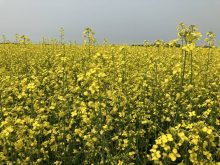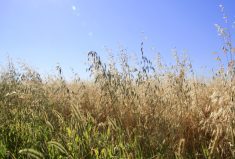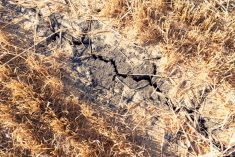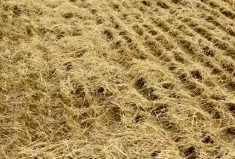Weather always gets talked about, but usually there are other issues that mark the year gone by.
But this was a year when the rain gauge and thermometer were front and central from spring to harvest.
Or rather, what passed for harvest. With about 1.6 million acres of crops still in the field, the story of the 2019 growing season won’t be over until well into next spring for many producers.
It was also a year when catching a break here and there (or not catching one) made a huge difference — a theme in the stories of these three producers.
Hannah Konschuh, Cluny

“We had a rough year on our farm. I hate to report it, but that’s the only way to sum it up,” said Konschuh, who experienced her third straight year of very dry conditions.
“We’re down in the southeastern corner of Wheatland County and we didn’t catch any moisture until the end of July or first part of August. By that point, it was too late.”
They had below-average crop yields, and an extremely challenging harvest.
“Production-wise, it was a rough year.”
But Konschuh is thinking positive — hoping to rebuild soil moisture in 2020 and bring in an above-average crop.
Her parents started farming in the late ’80s and she joined them in 2013.
Read Also

New crop insurer policy enables easier startup for faba beans
Agriculture Financial Services Corporation updated its normals for faba beans, which may open the door for more Canadian producers to feel comfortable growing the pulse crop in the future.
“This will be our sixth harvest. We’ve established some synergies and efficiencies and have been working really well together,” she said. “To me, that was one of the silver linings. On that front, everything is going quite well.”
Not so when it comes to trade barriers.
“Those are weighing pretty heavily on us as well,” said Konschuh, who is vice-chair of Alberta Wheat.
The family has mostly set their rotation for next year, but will also be leaving some acres free in case something shifts over the winter in the pulse or canola markets.
“Those are the things that we’re keeping an eye on,” she said.
On a business level, Konschuh has also been involved in the reform of the business risk management program under the Canadian Agricultural Partnership.
“The commissions and Team Alberta are involved in that work, but I sit on the national advisory committee as an individual producer,” she said. “Everything has come to a critical point and so we’re really pushing both levels of government to help us move forward with the reform of the program in the short term and the long term.
“I’m hoping that there are some positive changes there in the 2020 season. One thing that we’ve really been pushing for is removal of the reference margin limit. It’s something I’ve been spending a lot of time on.”
Christi Friesen, Peace River

“It wasn’t a typical year” is Friesen’s summary of the past year.
Friesen and her husband had canola, wheat and barley in rotation this year. They had good moisture starting in the spring, but then after high winds, everything dried out.
“A lot of our crops had very late germination,” said Friesen, adding some of the canola didn’t even germinate until June.
“Those quarters were bad. Those fields were very patchy. We had patches of one quarter section that were in the two-leaf stage, and some that were in bolting, and some in field that were already starting to pod. It was super sporadic in the field due to moisture.”
Their crops were also affected by the cool temperatures and smoke from the forest fires up north.
“I’ve never seen anything like it,” she said. “The smoke was so thick for a week that we didn’t see the sun. There was no sun, and no hot days to keep things moving along.”
Then came a very early frost.
“On Aug. 10, it was -1 C, anywhere to -4 C in some places. It could have been a killing frost in places. It hurt us a lot,” said Friesen, a regional rep for Alberta Wheat.
Even a light frost of -1 C can affect falling numbers.
“That is a huge concern in the Peace this year. The falling numbers are so low it’s unreal. I’ve never seen anything like it before.”
Friesen has some fields that are over 300 for falling number, some that are 150 and some that are 200.
“It totally depends on where the frost hit,” she said.
The frost also hurt the canola, because of the late germination, but it was the wheat and barley that took the big hits.
But their luck turned at harvest.
“In the MD of the Peace, there’s only a handful of us who were able to get our crops completely off,” she said, added they finished harvesting on Thanksgiving weekend and got snow right after.
They had straight cut 1,300 acres of canola, and didn’t swath anything.
“We were very fortunate in that sense. Any time it rained or snowed, we were able to get back into the field a little sooner,” she said.
The Friesens had decent yields. They had created a fertility plan and practices to try to go to higher yields, but because of the challenges of the year, they managed average yields.
Warren Sekulic, Rycroft

The year started off well for Sekulic, with good moisture and a decent start date (May 10) for seeding, which was pretty ordinary.
“But it was cold,” he said. “It was a little dry, but it wasn’t too bad at all. The summer hit, and it started getting wet. It was cold and it carried right through to fall, where we didn’t get a bunch of our crop off.”
The Peace got a lot of rain, but his operation saw a lot of showers, which were frequent but not enough to deluge the land.
“Right around Rycroft, it was perfect,” he said.
Sekulic had hopes of getting his best-ever yields, and while his crops were growing well, the lack of heat scuppered those hopes.
“We couldn’t get over how long our peas flowered. We still had peas with flowers in the middle of August, and we weren’t combining peas until the middle of September. Our wheat didn’t seem to want to mature and just stayed in there. Nothing seemed to want to ripen.”
Sekulic is farming next to his father, but they have separate farms. Between the two of them, they have 6,300 acres of wheat, peas, canola and oats this year. About half of their crop is still out.
“The scale of this is new,” he said. “We have left crop out in the fields before — we’re in the Peace Country. If you’re not anticipating harvest challenges, you’re not farming up here. (But) generally, we get it all off.”
But this year, things happened at an unprecedented scale.
“It’s unprecedented in how much that we’ve left out.”
Come spring, Sekulic will have to remove the crop that is now under the snow before he can seed.
“If you’re not getting going until the 7th or 10th of May, you’ve got less time to get it off and get it hammered back in,” he said.
He said it’s stressful because none of his plans are cemented. It’s difficult to create a cropping plan and book fertilizer and figure out what needs to be done, and where, said Sekulic.
“All of those management things that you usually have a pretty good handle on in the year are up in the air. Everything’s a variable right now.”
















